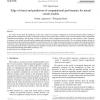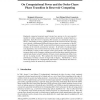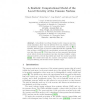7 search results - page 1 / 2 » Edge of chaos and prediction of computational performance fo... |
NN
2007
Springer
13 years 4 months ago
2007
Springer
We analyze in this article the signiļ¬cance of the edge of chaos for real-time computations in neural microcircuit models consisting of spiking neurons and dynamic synapses. We ļ...
NIPS
2008
13 years 6 months ago
2008
Randomly connected recurrent neural circuits have proven to be very powerful models for online computations when a trained memoryless readout function is appended. Such Reservoir ...
IWANN
2001
Springer
13 years 9 months ago
2001
Springer
Abstract. Intracellular recordings obtained under cutaneous and lemniscal stimulation show that the aļ¬erent ļ¬bers can establish excitatory and inhibitory synaptic connections w...
NIPS
2004
2004
Methods for Estimating the Computational Power and Generalization Capability of Neural Microcircuits
13 years 6 months ago
What makes a neural microcircuit computationally powerful? Or more precisely, which measurable quantities could explain why one microcircuit C is better suited for a particular fa...
BIOADIT
2004
Springer
13 years 10 months ago
2004
Springer
Abstract. Simple linear readouts from generic neural microcircuit models can be trained to generate and control basic movements, e.g., reaching with an arm to various target points...



